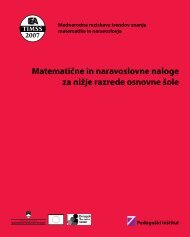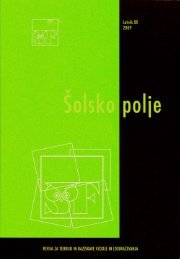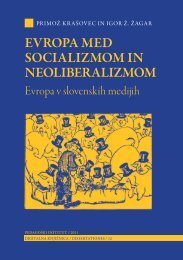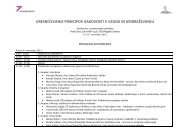80 ŠOLSKO POLJE LETNIK <strong>XX</strong> ŠTEVILKA 5/6history« (XV), usually to be found on the right of the political continuum.Often, they are in favour of the re-establishment of nostalgic practices thatare held to be markers of their group identity (Boym, 2001: 41). At thelevel of everyday life the results of this view are observable in the pedanticrestoration of monuments of the group’s »historical past«, changingthe names of streets and public spaces to reflect »our tradition«, rewritingof history in public discourse, etc. all in order to construct and supportone single narrative of national origin. Instances of this type of nostalgiaare easily found in the policies and acts of nationalistic parties all overformer Yugoslav states (Volčič, 2007). Or, specifically in the Serbian case,during the rallies in support of Karadžić and against his extradition to TheHague, many carried Karadžić’s and other nationalistic-historical figure’sphotos, sung songs about Greater Serbia and demanded renaming of thestreets in different Serbian cities after Karadžić and other Serbian nationalistic-historicalfigures (Repe, 2008). In that way, the re-articulation ofGreater Serbia as a homeland of Serbs took place. The fantasy is to replaceold symbolic names with the names of Serbs associated with the visionof Greater Serbia. Such symbolism feeds the nostalgic sense of longingfor some golden times and hope for the return of the late 1980s and early1990s, when Serbia still had a strategic power and control over most partsof former Yugoslavia. However, the important element of the nostalgicsentiment is that its objects are not available in the present. The point isthat nostalgia is only experienced in the present, but only in relation tothings from the past, which by the definition can never be again.Serbian (Nationalistic) JournalismThe media, and especially television, were among the crucial tools of the wareffort in all former Yugoslav republics, and controlled by the nationalisticand populist forces, inciting ethnic hatred and denigrating the democraticopposition. In Serbia, during the 1990s, there was a dominant professionalideology of a so-called »nationalistic journalism.« There are a lot of elementscharacteristic of this journalistic discourse (De la Broose, 2003; Milivojević,1996, 2007; Milošević, 2008; Suša, 2005): »us-versus-them« dichotomy, »mynation-right-or-wrong«version of reporting, substantiation of the myths ofsuperiority of the Serbian nation in relation to the other nations of the formerYugoslavia, and forging a sense of national pride and patriotism.Changes in media policy came after the fall of Milošević’s regime inOctober 2000, and ended the dominance of state television, but the poli-
JOURNALISTIC (RE)PRODUCTION OF HISTORY: TELEVIZED COVERAGE OF RADOVAN ...81cy changes still remain incomplete. The changes regulating the televisionwere carried out chaotically, without any clear policy or legal frameworks.The new government recognized the importance of state television andslowed down the changes. TS, according to Milivojević (2007) does notplay an explicit propagandistic role any more, since it does not use militantexclusionary practices and national hysteria. However, as many scholarsnote (e.g. Erjavec and Volčič, 2007; Milivojević, 2007; Suša, 2005), despitethe fact that TS attempted to transform itself into a public service institution,TS does work as a state television, since it is not independent fromgovernmental structures and it still predominately reproduces dominantpolitical discourse. Milivojević (2007) asks a crucial question as to how TSshould confront the traumatic past of the nation, since TS itself helped tolegitimate, normalize and institutionalize a particular war culture that supportedthe expansionist and nationalist politics of the Serbian regime.Method: Principles of recontextualization and representation ofsocial actorsThe mainstream research on media discourses in recent years has been focusedon a broad framework of a critical discourse analysis, which is concernedwith diverse issues such as the projection of power through discourse,the instantiation of dominance and inequality in discourse, the ideologicalunderpinning of discourse and discourse’s affiliation with social change(Fairclough, 1989, 1995a, 1995b; 2003; van Dijk, 1988, 1989, 1993).Fairclough (2003) and Chouliaraki and Fairclough (1999) adoptBernstein’s (1990) definition of recontextualization as a representationof social events. In the process of recontextualization, social events arenot merely repeated. Rather, they are transformed in their new setting,perhaps through the addition of new elements, or through the deletionof others. In connection, Tannock (1995: 454) suggests that we can onlyascertain whether nostalgia is progressive or regressive if we examinewhat has been excluded from a representation of the past. In his words,we need to »center essentially on what has been edited out of the nostalgictext – on the conflicts of interest and differences of position that areoccluded, on the social groups and relations that are cut out of the picture,on the hidden values that may, intentionally or not, be in the process ofbeing legitimated« (Tannock, 1995: 457).The arrangement of events may change in the new context, or some elementsmay be substituted for others. While recontextualization often invol-
- Page 3:
VSEBINA LETNIK XX ŠTEVILKA 5/6 Z
- Page 7 and 8:
UVODNA NOTICAIgor Ž. ŽagarTole pi
- Page 9 and 10:
ZA KAJ GRE V KAD - PREGLEDZGODOVINE
- Page 11 and 12:
ZA KAJ GRE V KAD - PREGLED ZGODOVIN
- Page 13:
ZA KAJ GRE V KAD - PREGLED ZGODOVIN
- Page 17 and 18:
ZA KAJ GRE V KAD - PREGLED ZGODOVIN
- Page 19 and 20:
ZA KAJ GRE V KAD - PREGLED ZGODOVIN
- Page 21 and 22:
ZA KAJ GRE V KAD - PREGLED ZGODOVIN
- Page 23 and 24:
ZA KAJ GRE V KAD - PREGLED ZGODOVIN
- Page 25 and 26:
ZA KAJ GRE V KAD - PREGLED ZGODOVIN
- Page 27 and 28:
DISKURZ: FOUCAULT, LACLAU TERZAPOPA
- Page 29 and 30:
DISKURZ: FOUCAULT, LACLAU TER ZAPOP
- Page 31 and 32: DISKURZ: FOUCAULT, LACLAU TER ZAPOP
- Page 33 and 34: DISKURZ: FOUCAULT, LACLAU TER ZAPOP
- Page 35 and 36: DISKURZ: FOUCAULT, LACLAU TER ZAPOP
- Page 37 and 38: DISKURZ: FOUCAULT, LACLAU TER ZAPOP
- Page 39 and 40: DISKURZ: FOUCAULT, LACLAU TER ZAPOP
- Page 41 and 42: DISKURZ: FOUCAULT, LACLAU TER ZAPOP
- Page 43 and 44: DISKURZ: FOUCAULT, LACLAU TER ZAPOP
- Page 45 and 46: DISKURZ: FOUCAULT, LACLAU TER ZAPOP
- Page 47 and 48: DISKURZ: FOUCAULT, LACLAU TER ZAPOP
- Page 49 and 50: TOPOI IN CRITICAL DISCOURSE ANALYSI
- Page 51 and 52: TOPOI IN CRITICAL DISCOURSE ANALYSI
- Page 53 and 54: TOPOI IN CRITICAL DISCOURSE ANALYSI
- Page 55 and 56: TOPOI IN CRITICAL DISCOURSE ANALYSI
- Page 57 and 58: TOPOI IN CRITICAL DISCOURSE ANALYSI
- Page 59 and 60: TOPOI IN CRITICAL DISCOURSE ANALYSI
- Page 61 and 62: TOPOI IN CRITICAL DISCOURSE ANALYSI
- Page 63 and 64: TOPOI IN CRITICAL DISCOURSE ANALYSI
- Page 65 and 66: TOPOI IN CRITICAL DISCOURSE ANALYSI
- Page 67 and 68: TOPOI IN CRITICAL DISCOURSE ANALYSI
- Page 69 and 70: TOPOI IN CRITICAL DISCOURSE ANALYSI
- Page 71 and 72: TOPOI IN CRITICAL DISCOURSE ANALYSI
- Page 73 and 74: TOPOI IN CRITICAL DISCOURSE ANALYSI
- Page 75 and 76: TOPOI IN CRITICAL DISCOURSE ANALYSI
- Page 77 and 78: University of Queensland, Centre fo
- Page 79 and 80: JOURNALISTIC (RE)PRODUCTION OF HIST
- Page 81: JOURNALISTIC (RE)PRODUCTION OF HIST
- Page 85 and 86: JOURNALISTIC (RE)PRODUCTION OF HIST
- Page 87 and 88: JOURNALISTIC (RE)PRODUCTION OF HIST
- Page 89 and 90: JOURNALISTIC (RE)PRODUCTION OF HIST
- Page 91 and 92: JOURNALISTIC (RE)PRODUCTION OF HIST
- Page 93 and 94: JOURNALISTIC (RE)PRODUCTION OF HIST
- Page 95 and 96: JOURNALISTIC (RE)PRODUCTION OF HIST
- Page 97 and 98: JOURNALISTIC (RE)PRODUCTION OF HIST
- Page 99 and 100: JOURNALISTIC (RE)PRODUCTION OF HIST
- Page 101 and 102: JOURNALISTIC (RE)PRODUCTION OF HIST
- Page 103 and 104: THE VOICE OF AN AGENDA-SETTINGAUTHO
- Page 105 and 106: THE VOICE OF AN AGENDA-SETTING AUTH
- Page 107 and 108: THE VOICE OF AN AGENDA-SETTING AUTH
- Page 109 and 110: THE VOICE OF AN AGENDA-SETTING AUTH
- Page 111 and 112: THE VOICE OF AN AGENDA-SETTING AUTH
- Page 113 and 114: THE VOICE OF AN AGENDA-SETTING AUTH
- Page 115 and 116: THE VOICE OF AN AGENDA-SETTING AUTH
- Page 117 and 118: THE VOICE OF AN AGENDA-SETTING AUTH
- Page 119 and 120: THE VOICE OF AN AGENDA-SETTING AUTH
- Page 121 and 122: THE VOICE OF AN AGENDA-SETTING AUTH
- Page 123 and 124: THE VOICE OF AN AGENDA-SETTING AUTH
- Page 125 and 126: THE VOICE OF AN AGENDA-SETTING AUTH
- Page 127 and 128: THE VOICE OF AN AGENDA-SETTING AUTH
- Page 129 and 130: THE VOICE OF AN AGENDA-SETTING AUTH
- Page 131 and 132: THE VOICE OF AN AGENDA-SETTING AUTH
- Page 133 and 134:
THE VOICE OF AN AGENDA-SETTING AUTH
- Page 135 and 136:
‘68 KOT HKRATNA KRIZA EVROPSKEGAZ
- Page 137 and 138:
‘68 KOT HKRATNA KRIZA EVROPSKEGA
- Page 139 and 140:
‘68 KOT HKRATNA KRIZA EVROPSKEGA
- Page 141 and 142:
‘68 KOT HKRATNA KRIZA EVROPSKEGA
- Page 143 and 144:
‘68 KOT HKRATNA KRIZA EVROPSKEGA
- Page 145 and 146:
‘68 KOT HKRATNA KRIZA EVROPSKEGA
- Page 147 and 148:
‘68 KOT HKRATNA KRIZA EVROPSKEGA
- Page 149 and 150:
‘68 KOT HKRATNA KRIZA EVROPSKEGA
- Page 151 and 152:
‘68 KOT HKRATNA KRIZA EVROPSKEGA
- Page 153 and 154:
‘68 KOT HKRATNA KRIZA EVROPSKEGA
- Page 155 and 156:
‘68 KOT HKRATNA KRIZA EVROPSKEGA
- Page 157 and 158:
‘68 KOT HKRATNA KRIZA EVROPSKEGA
- Page 159 and 160:
POVZETKI/ABSTRACTSZA KAJ GRE V KAD
- Page 161 and 162:
POVZETKI / ABSTRACTS159NOVINARSKA (
- Page 163 and 164:
POVZETKI / ABSTRACTS161‘68 AS PAR
- Page 165 and 166:
AVTORJI/AUTHORSRuth WodakRuth Wodak
- Page 168 and 169:
166 ŠOLSKO POLJE LETNIK XX ŠTEV
- Page 170 and 171:
168 ŠOLSKO POLJE LETNIK XX ŠTEV
- Page 172:
ZAHVALARevija Šolsko polje izhaja
















